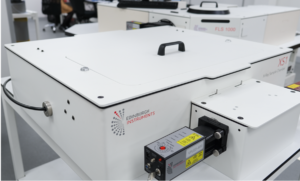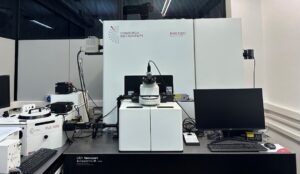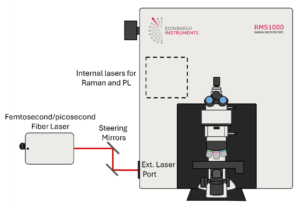
Send us your samples, and we can measure them live in an online demonstration
Contact us to arrange an online demonstration
"*" indicates required fields
Our development teams work closely with you to tailor our instruments to your specific needs. We pride ourselves on taking on the biggest challenges, contributing to future scientific advancements. If you have a unique enquiry, our dedicated sales team will connect you with our spectroscopy experts to develop an instrument precisely suited to your requirements.
We are committed to continuously evolving both our hardware and software to stay at the forefront of technological advancements in the field. Some of our bespoke systems are one-of-a-kind creations for researchers working on highly specialised applications, while others evolve into new products in our line-up. Each bespoke system is crafted with the utmost care and enthusiasm, recognising that any project could inspire the next addition to our product line.
Explore some examples of our bespoke work on the right. We look forward to collaborating with you to push the boundaries of our instruments and embark on the next exciting scientific venture together.

The XS1 radioluminescence chamber is one of many recent examples of user-driven innovation from Edinburgh Instruments. Time-resolved x-ray excited luminescence is emerging as an important technique to characterise scintillators, but until recently there were no commercially available spectrometers for this technique. This changed when a customer contacted us with an interesting problem: how to acquire time-resolved luminescence in the nanosecond range after exciting a sample with a short x-ray pulse.
The result is the XS1 accessory for the FLS1000 and FS5 spectrometers: a sample chamber hosting continuous and pulsed x-ray sources, enabling radioluminescence spectra and time-resolved experiments which are safe and user-friendly.

The XS1 sample chamber is external to the spectrometer. UV/Vis/NIR emission is collected by a liquid light guide (LLG) at 180˚ from the excitation beam and sent to the spectrometer sample chamber. Two x-ray sources can be coupled, a CW source for spectral and a pulsed x-ray source for time-resolved PL measurements with ~100 ps resolution. Measurements are carried out in the Fluoracle® software without additional packages required: performing advanced x-ray experiments in your FLS1000 or FS5 could not be easier.
Whilst the RMS1000 can be configured with a wide range of lasers, techniques, detectors and gratings as standard, sometimes that simply isn’t enough! Recently, we engineered a system that fully leverages its capabilities to their fullest extent.
Equipped with two spectrographs to enhance resolution and functionality, the RMS1000 facilitates numerous techniques thanks to its extensive array of lasers and detectors. Internally, this system integrates 4 CW diode lasers for Raman and photoluminescence (PL) measurements. In response to the customer’s existing EI pulsed lasers (EPL, HPL, and VPL series), the microscope was modified to seamlessly integrate filter cubes. This adjustment relieves pressure on the six-position filter turret, enabling unrestricted use of EPL/HPL/VPL lasers, and allowing additional external lasers to be coupled. The system includes two IR lasers for upconversion measurements, alongside a Ti:Sapphire laser coupled into the external port, offering shared compatibility with their FLS1000, shown in the image below.

To accommodate these diverse laser sources, the instrument houses 4 detectors: EMCCD, InGaAs, PMT, and NIR-PMT. Despite its complexity, Ramacle software efficiently manages and operates all internal components, ensuring user-friendly control while expanding capabilities to support a wide range of techniques—a true Multimodal RMS1000!
Techniques: Raman, PL, FLIM, Upconversion
Some novel semiconductors and phosphors require photoluminescence excitation < 200 nm, meaning that a standard spectrometer is not suitable for studying them. To address these growing applications, we customised the FLS1000 expanding its excitation range into the VUV (115 nm – 200 nm). The result is the FLS1000-VUV; a special version of the instrument featuring vacuum monochromators, detectors, and VUV sources.
The FLS1000-VUV can be configured for PL spectra and/or lifetimes, and standard or VUV emission range, depending on your needs. Options for samples at room temperature or in a software-controlled vacuum cryostat are available. If you are unsure on what options you require, our team is at hand to advise on the best configuration for your application.
Second harmonic generation (SHG) microscopy uses the sample’s ability to generate second harmonic light, highlighting areas lacking centrosymmetry within the material. This non-linear optical process occurs when two photons of the same wavelength interact, producing a photon with half the wavelength. SHG imaging is crucial in materials science for visualising crystal symmetry changes in 2D semiconductors, and in biological tissue to selectively image non-centrosymmetric structures such as fibrillar collagen.

We noticed a trend specifically with the 2D material market for a need to carry out correlative Raman, PL, and SHG imaging for full characterisation of these materials. This technique demands extremely high excitation intensity not afforded by our standard laser choices. It was time to adapt our RMS1000 to this new requirement!
As we look to evolve our instruments, we work with other business to test their products for integration with ours. We have subsequently loaned and tested several lasers capable of producing the SHG signal so we can offer a complete solution to customers interested in this technology. Additional work has been carried out to integrate polarisers to work with these lasers and provide a full, software controlled, solution.